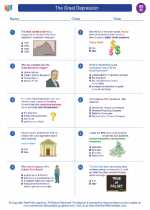The Great Depression
The Great Depression was a severe economic downturn that took place in the 1930s. It was the longest, deepest, and most widespread depression of the 20th century. The Great Depression began with the stock market crash of 1929 and lasted until the late 1930s, impacting both the United States and countries around the world.
Causes of the Great Depression
- Stock Market Crash: The stock market crash of 1929, also known as Black Tuesday, was a major factor in triggering the Great Depression. Stock prices plummeted, leading to a loss of confidence in the economy.
- Bank Failures: As a result of the stock market crash, many banks failed, leading to a loss of savings for individuals and a further decline in economic stability.
- Overproduction and Underconsumption: Industries were producing more goods than consumers could afford to buy, leading to a surplus of products and a decrease in demand.
- Protectionist Trade Policies: Countries imposed high tariffs and trade barriers, leading to a decrease in international trade and further economic decline.
- Drought and Dust Bowl: Severe drought and the Dust Bowl in the Great Plains led to agricultural devastation, affecting farmers and exacerbating the economic crisis.
Impact of the Great Depression
- Unemployment: The unemployment rate soared, reaching over 25% in the United States, and leaving millions without jobs.
- Homelessness and Poverty: Many people lost their homes and lived in makeshift shelters, known as "Hoovervilles," while others struggled to afford basic necessities.
- Global Economic Crisis: The effects of the Great Depression were felt worldwide, as international trade and economies suffered from the downturn.
- Social and Psychological Impact: The Great Depression took a toll on people's mental health and well-being, leading to increased stress, anxiety, and despair.
Government Response
In response to the Great Depression, governments implemented various policies and programs to address the economic crisis. In the United States, President Franklin D. Roosevelt's New Deal initiatives aimed to provide relief, recovery, and reform through measures such as the creation of public works projects, social welfare programs, and financial regulations.
Study Guide
To study the Great Depression, consider the following key points:
- What were the main causes of the Great Depression?
- How did the Great Depression impact individuals and families?
- What were the social and psychological effects of the Great Depression?
- What were the major government responses to the Great Depression?
- What were the long-term effects of the Great Depression on the global economy?
Additionally, it's important to examine primary sources, such as photographs, letters, and government documents from the time period, to gain a deeper understanding of the personal experiences and historical context of the Great Depression.
By studying the causes, impact, and responses to the Great Depression, students can gain insight into the complexities of economic crises and the ways in which societies and governments address such challenges.
[The Great Depression] Related Worksheets and Study Guides:
.◂Social Studies Worksheets and Study Guides Eighth Grade. The Great Depression

 Worksheet/Answer key
Worksheet/Answer key
 Worksheet/Answer key
Worksheet/Answer key
 Worksheet/Answer key
Worksheet/Answer key
 Worksheet/Answer key
Worksheet/Answer key
